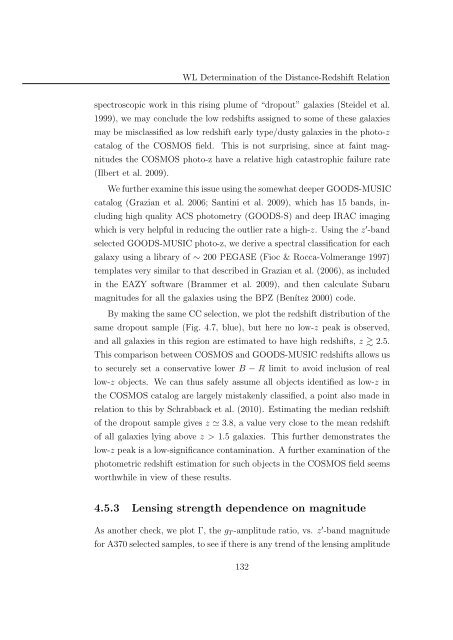Mass and Light distributions in Clusters of Galaxies - Henry A ...
Mass and Light distributions in Clusters of Galaxies - Henry A ...
Mass and Light distributions in Clusters of Galaxies - Henry A ...
Create successful ePaper yourself
Turn your PDF publications into a flip-book with our unique Google optimized e-Paper software.
WL Determ<strong>in</strong>ation <strong>of</strong> the Distance-Redshift Relation<br />
spectroscopic work <strong>in</strong> this ris<strong>in</strong>g plume <strong>of</strong> “dropout” galaxies (Steidel et al.<br />
1999), we may conclude the low redshifts assigned to some <strong>of</strong> these galaxies<br />
may be misclassified as low redshift early type/dusty galaxies <strong>in</strong> the photo-z<br />
catalog <strong>of</strong> the COSMOS field. This is not surpris<strong>in</strong>g, s<strong>in</strong>ce at fa<strong>in</strong>t magnitudes<br />
the COSMOS photo-z have a relative high catastrophic failure rate<br />
(Ilbert et al. 2009).<br />
We further exam<strong>in</strong>e this issue us<strong>in</strong>g the somewhat deeper GOODS-MUSIC<br />
catalog (Grazian et al. 2006; Sant<strong>in</strong>i et al. 2009), which has 15 b<strong>and</strong>s, <strong>in</strong>clud<strong>in</strong>g<br />
high quality ACS photometry (GOODS-S) <strong>and</strong> deep IRAC imag<strong>in</strong>g<br />
which is very helpful <strong>in</strong> reduc<strong>in</strong>g the outlier rate a high-z. Us<strong>in</strong>g the z ′ -b<strong>and</strong><br />
selected GOODS-MUSIC photo-z, we derive a spectral classification for each<br />
galaxy us<strong>in</strong>g a library <strong>of</strong> ∼ 200 PEGASE (Fioc & Rocca-Volmerange 1997)<br />
templates very similar to that described <strong>in</strong> Grazian et al. (2006), as <strong>in</strong>cluded<br />
<strong>in</strong> the EAZY s<strong>of</strong>tware (Brammer et al. 2009), <strong>and</strong> then calculate Subaru<br />
magnitudes for all the galaxies us<strong>in</strong>g the BPZ (Benítez 2000) code.<br />
By mak<strong>in</strong>g the same CC selection, we plot the redshift distribution <strong>of</strong> the<br />
same dropout sample (Fig. 4.7, blue), but here no low-z peak is observed,<br />
<strong>and</strong> all galaxies <strong>in</strong> this region are estimated to have high redshifts, z 2.5.<br />
This comparison between COSMOS <strong>and</strong> GOODS-MUSIC redshifts allows us<br />
to securely set a conservative lower B − R limit to avoid <strong>in</strong>clusion <strong>of</strong> real<br />
low-z objects. We can thus safely assume all objects identified as low-z <strong>in</strong><br />
the COSMOS catalog are largely mistakenly classified, a po<strong>in</strong>t also made <strong>in</strong><br />
relation to this by Schrabback et al. (2010). Estimat<strong>in</strong>g the median redshift<br />
<strong>of</strong> the dropout sample gives z ≃ 3.8, a value very close to the mean redshift<br />
<strong>of</strong> all galaxies ly<strong>in</strong>g above z > 1.5 galaxies. This further demonstrates the<br />
low-z peak is a low-significance contam<strong>in</strong>ation. A further exam<strong>in</strong>ation <strong>of</strong> the<br />
photometric redshift estimation for such objects <strong>in</strong> the COSMOS field seems<br />
worthwhile <strong>in</strong> view <strong>of</strong> these results.<br />
4.5.3 Lens<strong>in</strong>g strength dependence on magnitude<br />
As another check, we plot Γ, the g T -amplitude ratio, vs. z ′ -b<strong>and</strong> magnitude<br />
for A370 selected samples, to see if there is any trend <strong>of</strong> the lens<strong>in</strong>g amplitude<br />
132
















